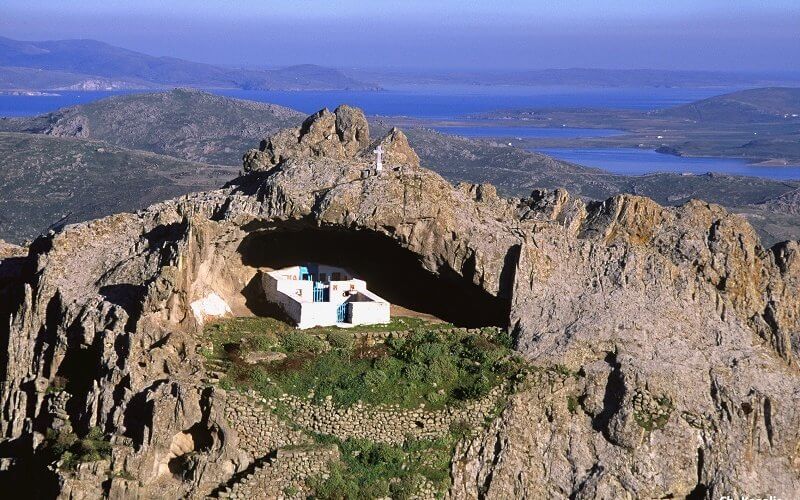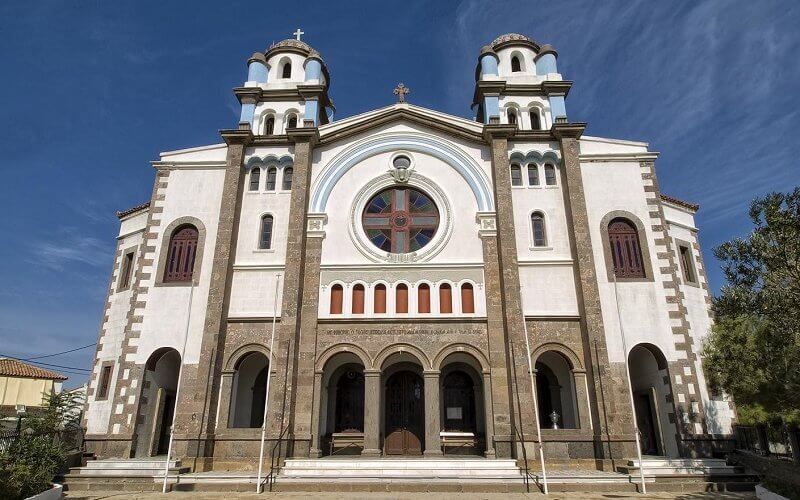The metropolitan church of Agia Triada (Holy Trinity) is found in Myrina and was built in 1865 by the empirical architect and marble sculptor Zaharias Filippotis. Historical sources indicate that an older church was found at the same location destroyed by the Turks after the Orlov revolt. It is an impressive three aisled domed basilica characterized by its two bell-towers at its façade. Its wood carved gilded templon is an exquisite work of art brought from the church of Agios Nikolaos of Myrina which was demolished during the Turkish dominion. At the church yard with the beautiful garden the bust of Ioakeim, the Metropolitan of Limnos, who was hanged by the Turks is found.
Agios Sozon is the patron saint and protector of Limnos. The small church of Agios Sozon is built next to the sea at the south east end of the island at the region of Fysini. In the past, there was a monastery there. It is said that seamen who were saved after a sea storm, when they reached the coast and faced the ruins of the monastery, thought that they were saved by the local unknown Saint. That’ s why they called it Agios Sozon (“sozo” means save). He is celebrated on 7th September. Each year in the eve of the Saints’ celebration a Devine Liturgy takes place at its chapel and crowds of people arrive there to celebrate the island’s Patron.
The holly church of Evaggelismos of Theotokos, known as church of Evaggelistria is an impressive parish church of Moudros. It was built in 1904 with personal work of local people and contributions by the “Evaggelismos” Educational Association of Moudros people living in the USA, which was constituted for this purpose. It is an imposing three-aisled basilica with bell-towers. There are impressive architectural elements such as the rosette at the church’s façade as well as the stone carved gate driving to the courtyard. In the past, at the church’s location the glebe of Agia Marina of the Koutloumousiou Monastery was found of which the altar and some buildings are saved. The Epitaph of the church is a donation of the admiral Pavlos Kountouriotis who was on Limnos during World War I.
The church of Taxiarches of Moudros known as church of Archangels was built in 1835 and has re-erected many times with the first report of its existence dating back to 1370. It is a three-aisled church with posterior outer narthex. It is the second most important church in Moudros after that of Evaggelistria, with a special elaborate carved templon made of chestnut wood coming from Mount Athos. The templon is considered to be a replica of that of Agia Foteini of Smyrna which was burnt during the Catastrophe of Smyrna in 1922. In its interior the threefold ancient marble relief inscription as well as the arch above the windows with a stone relief cross, are some of its impressive features.
The old church of Agios Georgios in Repanidi is a cemetery church, declared as a protected historical monument. It is a typical sample of three-aisled post-Byzantine basilica with neoclassic influences. There are sources reporting that 1860 was its year of establishment. This type of church is the most typical sample of ecclesiastical architecture in the post-Byzantine era on Limnos. The wood carved templon of the church is impressive, depicting the high aesthetics of the craftsmen who created it. The templon parapets with floral representations, the strong colours of the templon’s portable icons and of the bema doors indicate the unique art developed on Limnos as well as on the rest of the northeast Aegean islands during the post-Byzantine era.
Source: http://odysseus.culture.gr/h/2/eh255.jsp?obj_id=1670
The chapel of Panagia Kakkaviotissa is located near the village of Zemata in the area of Thanos (about 4 km from Myrina). Remnant of one of the numerous glebes on the island, it is known from 1305 when it came to the possession of the monastery of Agia Lavra, as some of its monks from the island of Ag. Efstratios settled in the chapel in order to protect themselves from the Turkish raids. It is located at a spectacular position in a hardly-reached cave, on the top of a hill among impressive rocks, a location in which in Byzantine years there was probably an Early-Christian church and hermits.
On the first Tuesday after Easter there is a service at the chapel. On that day the icon of the Virgin (Panagia) Kakaviotissa -which for the rest of the year is kept by a family at Kontia- is brought at the chapel. According to tradition, the members of this family are the descendants of a laborer to whom the last monk gave the icon in question.
Source: http://odysseus.culture.gr/h/2/eh251.jsp?obj_id=1711
The church of Gennisi of Christos (Christ’s Genesis) in Romano is one of the most impressive church monuments on the island. It was built in 1830 and is a three-aisled basilica. The carved stonework is harmonized with the local architecture. The neo-Gothic windows of its outer narthex and the carved capitals are distinguished. The exceptional icons of the church as well as the wood carved templon represent Bible images and in their majority, they have been created by Efstratios Haimante, an iconographer from Imvros.
The church of Agios Ioannis Prodromos in Kondias was built in 16th century and is of fort architecture with crenellations and canons, proving that during its erection the pirates’ attacks were frequent. The icons decorating the small church attract the visitors’ interest.
The church of Agios Modestos is found at the village of Katalakkos. The church was built in 1856 at the lowest part of the village by its inhabitants who dedicated it to the patron Saint of animals. It has a two-pitch roof and in its interior, there are impressive colourful wood carved parapets created in the beginning of 20th century. On 18th December, the celebration day of the Saint, pilgrims arrive to pray to the Saint, among them the stockbreeders of Limnos called Kehagiades.
The church of Agios Georgios in Atsiki was built by locals in 1856 and it is a three-aisled basilica. It has a neoclassical decoration, capitals of Corinthian order and Russian style icons. It is well-known on the island due to its imposing stone bell-tower built in 1928. Its craftsman was the stone sculptor Giannis Fotiadis from Sampsounta and this is considered its masterpiece. Its size is 5×5 and is decorated with elaborate carved capitals. It is the biggest bell-tower of Limnos.
The church of Zoodohos Pigi in Kotsinas was built on a hill where in the past the castle of Kotsinas was found. The church was re-erected with expatriates’ donations in 1950 at the place of a previous church. From its historical past, only the part of the Byzantine architrave is saved today. It is well known for the holly water coming from an underground spring under the church. To reach it you should go down 64 stairs leading to a carved rock. In Easter’s Friday many people from all over the island visit it to participate in the great feast taking place at the church’s yard. There you can also find the statue of Maroula. It is said that Maroula was the woman who encouraged the inhabitants of the region to resist the Turks who seized the castle of Kotsinas in 1478.
The chapel of Panagia of Trygi is found at the village of Propouli. Already from 1364 there are reports that it was a glebe of Mount Athos’ monastery of Simonos Petra. From the previous stone construction, the east side is only saved with the chancel’s three-sided structure and an inscription. In the chapel there are icons of high aesthetics, with the most important of them the icon of Panagia Odigitria which has been there since 1700 and is considered miraculous. It is worth mentioning that in that icon Panagia (Virgin Mary) is represented wearing a white veil instead of the usual red one. It is celebrated on 15th August when many people are gathered there from all over Limnos and other places of Greece.
The chapel of Agia Paraskevi is built next to the mansion Vodela that’s why often it is referred as Agia Paraskevi of Vodela. It is found at the feet of the Castle of Myrina and has a view to the beach of Romeikos Yalos.
Other countryside chapels on the island are Agios Charalampos in Plaka, Agios Ermolaos in Atsiki, Agios Giannis in Kaspakas, Agios Nikolaos on the hill over the new port in Myrina as well as Profitis Ilias found at a height of 355m in Therma, the thermal springs of the island. In the eve of Profitis Ilias’ celebration, many inhabitants and visitors of the island climb uphill and overnight there.


 Greek
Greek




